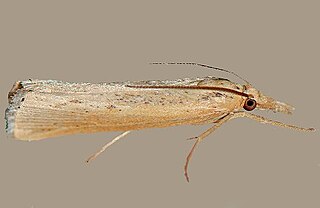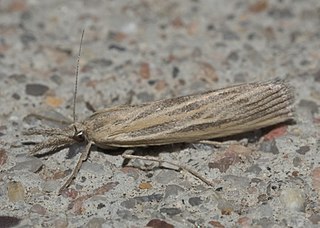Mimoschinia is a genus of moths of the family Crambidae. It contains only one species, Mimoschinia rufofascialis, the rufous-banded pyralid moth or barberpole caterpillar, which is found in the Caribbean, from Alberta to British Columbia, south to Texas and California and in Mexico.
Pseudoschoenobius is a genus of moths of the family Crambidae. It contains only one species, Pseudoschoenobius opalescalis, which is found in North America, where it has been recorded from Alberta, Illinois, Indiana, New Mexico and California. The habitat consists of dry, sandy areas.

Perispasta is a genus of moths of the family Crambidae. It contains only one species, Perispasta caeculalis, or Titian Peale's pyralid moth, which is found in North America, where it has been recorded from Quebec west to British Columbia, south to Florida, Texas and Colorado. The habitat consists of fields and meadows. Both the genus and species were first described by Philipp Christoph Zeller in 1875.

Tehama is a genus of moths of the family Crambidae. It contains only one species, Tehama bonifatella, the western lawn moth, which is found in Greenland and North America, where it has been recorded from Alberta, British Columbia, California, Colorado, Labrador, Manitoba, Nevada, Quebec and Washington. The habitat consists of grasslands.

Chrysoteuchia topiarius, the topiary grass-veneer moth, subterranean sod webworm or cranberry girdler, is a moth of the family Crambidae. The species was first described by Philipp Christoph Zeller in 1866. It is found in most of North America.

Dioryctria reniculelloides, the spruce coneworm, is a moth of the family Pyralidae. The species was first described by Akira Mutuura and Eugene G. Munroe in 1973. It is found from Nova Scotia to Alaska, south in the east to New York, and south in the west to California and New Mexico. It was recorded from China in 2009. Occasionally abundant, often in conjunction with epidemics of the spruce budworm, the spruce coneworm occurs through most or all of the range of spruce in North America, feeding on new foliage and cones of spruce, and often balsam fir. When abundant, it can be a serious pest "particularly on white spruce".
Dioryctria pentictonella is a species of snout moth in the genus Dioryctria. It was described by Akira Mutuura, Eugene G. Munroe and Douglas Alexander Ross in 1969 and is found in North America from British Columbia south to California.
Agriphila attenuata is a moth in the family Crambidae. It was described by Augustus Radcliffe Grote in 1880. It is found in North America, where it has been recorded from coastal California, Washington, Wyoming, British Columbia and Alberta. The habitat consists of grasslands.

Agriphila plumbifimbriella is a moth in the family Crambidae. It was described by Harrison Gray Dyar Jr. in 1904. It is found in North America, where it has been recorded from British Columbia, Alberta and the western United States. The habitat consists of grassland areas in mountains and foothills.

Catoptria oregonicus, the western catoptria or Oregon catoptria moth, is a moth in the family Crambidae. It was described by Augustus Radcliffe Grote in 1880. It is found in North America, where it has been recorded from British Columbia and Alberta to Montana, Oregon and northern coastal California. The habitat consists of meadows in the mountains and foothills.

Crambus whitmerellus, or Whitmer's grass-veneer, is a moth in the family Crambidae. It was described by Alexander Barrett Klots in 1942. It has been recorded in North America from Alberta, Montana, Wyoming, Colorado and Utah. The habitat consists of grasslands.

Crambus leachellus, or Leach's grass-veneer, is a moth in the family Crambidae. It was described by Johann Leopold Theodor Friedrich Zincken in 1818. It is found in North America, where it has been recorded from Ontario and Maryland to Florida, west to California and Oregon. The habitat consists of grasslands and meadows.
Crambus trichusalis is a moth in the family Crambidae. It was described by George Duryea Hulst in 1886. It is found in North America, where it has been recorded from Alberta, Saskatchewan, Montana, North Dakota and South Dakota. The habitat consists of grasslands.
Crambus unistriatellus, the wide-stripe grass-veneer, is a moth in the family Crambidae. It was described by Alpheus Spring Packard in 1867. It is found in North America, where it has been recorded from British Columbia, Alberta, Labrador, Maine, Michigan, New Hampshire, New York, Pennsylvania, Minnesota and California. The habitat consists of grasslands.

Neodactria luteolellus, the mottled grass-veneer, is a moth in the family Crambidae. It was described by James Brackenridge Clemens in 1860. It is found in North America, where it has been recorded from Labrador and Quebec to North Carolina, west to Arizona and California and north to Alberta. The habitat consists of grassland areas in prairies, aspen parklands and boreal forests.
Pediasia abnaki is a moth in the family Crambidae. It was described by Alexander Barrett Klots in 1942. It is found in North America, where it has been recorded from Maine, Michigan, Nova Scotia, Ohio, Alberta, Quebec, Ontario and New Brunswick. The habitat consists of grasslands.
Thaumatopsis fernaldella is a moth in the family Crambidae. It was described by William D. Kearfott in 1905. It is found in North America, where it has been recorded from Alberta, California, Florida, Maryland, Mississippi, Nevada, New Mexico, Oklahoma, Saskatchewan and Texas. The habitat consists of prairies.

Thaumatopsis pexellus, the woolly grass-veneer, is a moth in the family Crambidae. It was described by Philipp Christoph Zeller in 1863. It is found in most of North America. The habitat consists of grasslands.
Evergestis subterminalis is a moth in the family Crambidae. It was described by William Barnes and James Halliday McDunnough in 1914. It is found in western North America, where it has been recorded from west central Alberta south to Colorado, Utah and California. The habitat consists of montane meadows.

Pyrausta unifascialis, the one-banded pyrausta, is a moth in the family Crambidae. It was described by Alpheus Spring Packard in 1873. It is found in North America, where it has been recorded from Quebec west to British Columbia, south to Arizona and California. The habitat consists of forest openings, clearings and fields.










